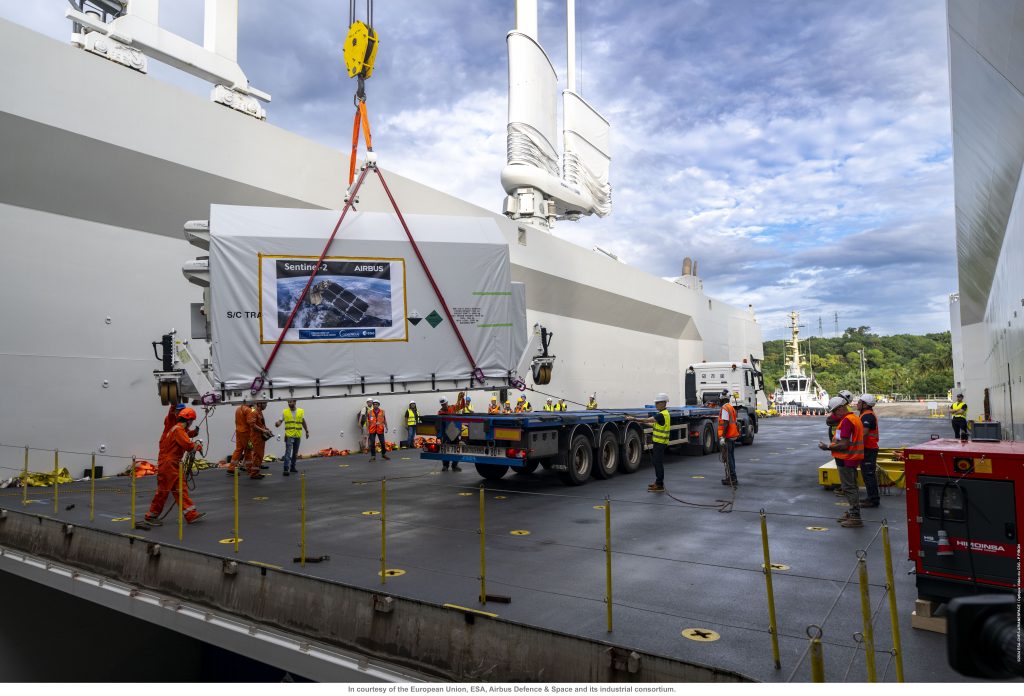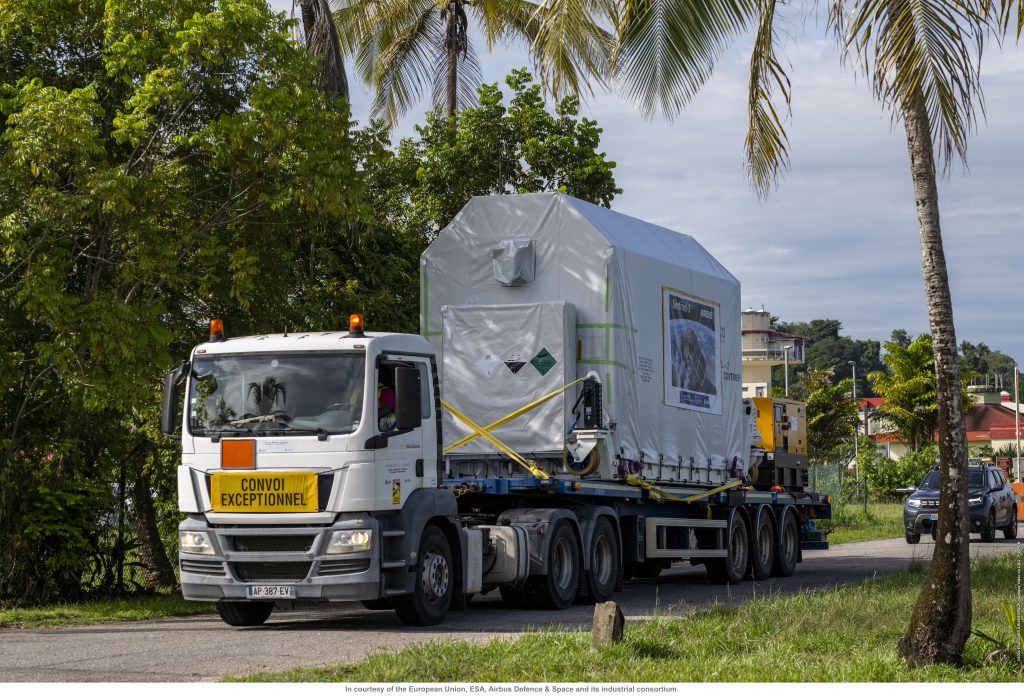Scheduled to be launched in September on a Vega rocket, the Copernicus Sentinel-2C satellite arrived by ship at the European Spaceport in French Guiana a few days ago – and has since been lifted out of its transport container.
Sentinel-2C is the third Sentinel-2 satellite to provide high-resolution images of Earth for numerous applications such as for monitoring land-cover change and plant health, for monitoring water quality and changes in ice cover.
The Sentinel-2 mission is based on two identical satellites orbiting Earth 180° apart for optimal coverage and revisit times. To ensure a continuous data supply from a pair of satellites for Copernicus Services and more, Sentinel-2C will take over from Sentinel-2A which was launched back in 2015. Later, Sentinel-2D will take over from Sentinel-2B which was launched in 2017.
For now, the task in hand is to get Sentinel-2C ready for launch.

Sentinel-2C at Airbus’ facilities in Friedrichshafen being prepared for shipment. (Airbus)
The satellite, and equipment needed for the launch campaign, was transported from Airbus’ cleanroom in Friedrichshafen to Bremen harbour by road on 2 July. The next day it was loaded onto the Canopée sail-assisted container ship for its two-week voyage to French Guiana.

Loading Sentinel-2C onto the Canopée ship in Bremen harbour. (CEVA Logistics)
While Sentinel-2C was being carried across the Atlantic Ocean, the ‘Operations Validation Campaign’ got underway at ESA’s Operations Centre (ESOC) in Darmstadt Germany. From here, spacecraft operators will look after Sentinel-2C throughout its life in orbit.

Operators preparing for Sentinel-2C launch. (ESA)
However, the start of the satellite’s life is critical. Acquiring the satellite telemetry and taking control as soon as possible after its release into orbit is essential, as are the first few days of operations, called the Launch and Early Obit Phase.’
So, the team at ESA’s Operations Centre got stuck in preparing for this important stage.
With Sentinel-2C on-route and spacecraft operators in preparations, the launch campaign team, including people from ESA and Airbus, also headed off to Kourou in French Guiana to get things set up for the satellite’s arrival.
Once in Kourou, the 15-strong advance team set to work planning, doing safety training, checking the facilities for cleanliness and finalising various legal and operational documentation with the base and launcher authority.
The container ship arrived on 19 July – and some of the team members were lucky enough to see it passing by from the beach at Les Roches, before entering the Kourou river.

Canopée arrives. (ESA)

Canopée heads to the harbour. (ESA-CNES-ARIANESPACE/Optique vidéo du CSG–S. Martin)
The following day, the Sentinel-2C container and equipment were unloaded.

Unloading Sentinel-2C. (ESA-CNES-ARIANESPACE/Optique vidéo du CSG–S. Martin)

Smiles after unloading. (ESA)
Once everything had been unloaded from the ship the convoy set off for the Spaceport.

Sentinel-2C convoy on route to Europe’s Spaceport. (ESA-CNES-ARIANESPACE/Optique vidéo du CSG–S. Martin)

Convoy arrives. (ESA)
The acceptance of the Payload Preparation Facility (S1A) was successfully concluded. It was a prerequisite to proceed with the opening of the satellite transport container in the cleanroom. With this first important milestone, the launch campaign officially started on 22 July.
A lot of unpacking, transferring, cleaning and setting up the ground support equipment, had to be done first, as well as making sure the office space was operational.
The link with ESOC via the NDIU routers had also been established by the end of a very long day. This link allows satellite realtime telemetry to be sent to the operations control centre during the final countdown.
Then on 23 July, everything was in place to open the satellite container and hoist out Sentinel-2C!
The next things on the to-do list includes switching the satellite on.

Lifting the container lid. (ESA-CNES-ARIANESPACE/Optique vidéo du CSG–S. Martin)

Sentinel-2C revealed. (ESA-CNES-ARIANESPACE/Optique vidéo du CSG–S. Martin)

Keeping a close eye on this important moment. Sentinel-2C revealed. (ESA-CNES-ARIANESPACE/Optique vidéo du CSG–S. Martin)
Read more about the Copernicus Sentinel-2 mission.

Discussion: no comments